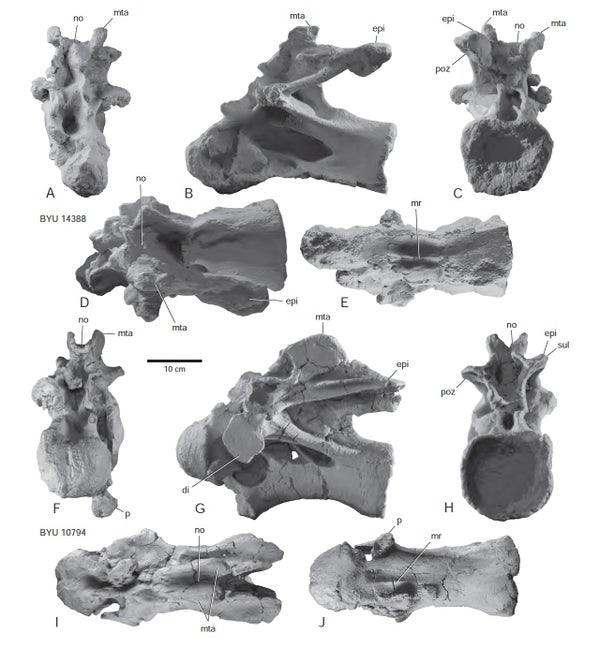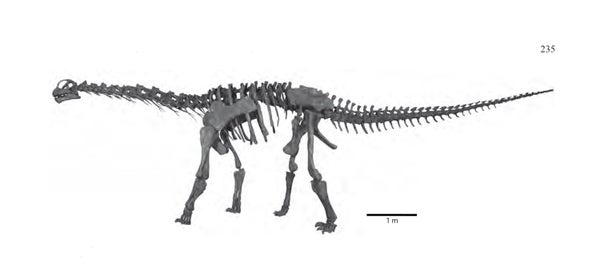This article was published in Scientific American’s former blog network and reflects the views of the author, not necessarily those of Scientific American
Six years ago, shortly after I moved to Utah, I took a short drive down the highway to Brigham Young University's Museum of Paleontology. I was hungry to get acquainted with the dinosaurs of my new desert home, and I knew the Mormon college's little museum had a few I hadn't seen before. One of them, a blunt-skulled sauropod, stood against a dimly-lit wall. I didn't recognize it. The great herbivore looked somewhat like the spoon-toothed Camarasaurus of Jurassic time, but the museum identified this dinosaur as something different. Exactly what, it didn't say. The sauropod didn't have an official name yet, reconstructed but awaiting publication. Now that's changed, and we can welcome Moabosaurus utahensis to the dinosaur family tree.
As you might guess from the dinosaur's name, Moabosaurus hails from the vicinity of Moab, at the heart of Utah's dinosaur country. Its remains were among over 5,500 fossils excavated from the Dalton Wells Quarry at intervals between 1975 and 2005, paleontologist Brooks Britt and colleagues write, yielding various elements of the new sauropod.
The geologic age of Moabosaurus alone makes it noteworthy. Even though western North America was practically swarming with sauropod dinosaurs at the end of the Jurassic, by the time the Dalton Wells Quarry formed - around 125 million years ago - sauropod diversity had plummeted. The herbivorous giants were still around, but they apparently become much less diverse and rarer on the landscape. Moabosaurus is one of those hard-to-find giants.
So what flavor of sauropod was Moabosaurus? That's a little unclear as yet. The dinosaur seems to hover around the part of the sauropod family tree that includes other stout species like Camarasaurus, Erketu and Euhelopus from Asia, and early titanosaurs. In broad terms, Moabosaurus seems to be another example of the stouter, larger-toothed sauropod forms of the Late Jurassic continuing on while the more slender Diplodocus-like forms vanished from North America. The question is what gave these particular forms of sauropod an edge over their relatives, and the answer to that is still held in the fossil record.

Neck vertebrae of Moabosaurus. Credit: Britt et al. 2017
Fossil Facts
On supporting science journalism
If you're enjoying this article, consider supporting our award-winning journalism by subscribing. By purchasing a subscription you are helping to ensure the future of impactful stories about the discoveries and ideas shaping our world today.
Name: Moabosaurus utahensis
Meaning: "Moab lizard from Utah", in reference to the town near the fossil quarry this dinosaur was recovered from.
Age: Cretaceous, about 125 million years ago.
Where in the world?: Utah, U.S.A.
What sort of organism?: A sauropod dinosaur.
Size: About 32 feet long.
How much of the organism’s is known?: Over 70 specimens from multiple individuals, including parts of the skull, spine and limbs.
Reference:
Britt, B., Scheetz, R., Whiting, M., Wilhite, D. 2017. Moabosaurus utahensis, n. gen., n. sp., a new sauropod from the Early Cretaceous (Aptian) of North America. Contributions from the Museum of Paleontology, University of Michigan. 32 (11): 189-243
Previous Paleo Profiles:
The Light-Footed Lizard The Maoming Cat Knight’s Egyptian Bat The La Luna Snake The Rio do Rasto Tooth Bob Weir's Otter Egypt's Canine Beast The Vastan Mine Tapir Pangu's Wing The Dawn Megamouth The Genga Lizard The Micro Lion The Mystery Titanosaur The Echo Hunter The Lo Hueco Titan The Three-Branched Cicada The Monster of Minden The Pig-Footed Bandicoot Hayden's Rattlesnake Demon The Evasive Ostrich Seer The Paradoxical Mega Shark The Tiny Beardogs The Armored Fish King North America's Pangolin The Invisible-Tusked Elephant The Mud Dragon The Spike-Toothed Salmon The Dream Coast Crocodile Buriol's Robber Ozimek's Flyer The Northern Naustoceratopsian The High Arctic Flyer The Tomatillo From the End of the World The Short-Faced Hyena The Mighty Traveler from Egg Mountain Keilhau's Ichthyosaur Mexico's Ancient Horned Face Mauricio Fernández's Plesiosaur New Zealand's Giant Dawn Penguin The Orange Sea Lion Mongolia's Ginkgo Cousin The Geni River Frog Isabel Berry's Dinosaur The Whale Caiman
